Modularity-Based Incremental Label Propagation Algorithm for Community Detection
Abstract
1. Introduction
2. Methods and Materials
2.1. LPA
2.2. Evaluation Metrics
2.2.1. Normalized Mutual Information
- when the community partition generated by one algorithm is consistent with the real community structure.
- when the community partition generated by one algorithm is the opposite of the real community structure.
- when the community partition generated by one algorithm is partly similar to the real community structure. The closer to 1 the NMI value, the closer to the real community structure the community detection result, and the better the performance of the algorithm.
2.2.2. Modularity
2.3. MILPA
- All nodes in the network are assigned into a set and given the same label .
- The intensity of all nodes in set is calculated according to Equation (4).
- Among the nodes in , the node with the highest intensity and its neighbors are put into a new set, denoted by .
- For any node if the membership degree of to is less than , it indicates that node is not closely connected with other nodes in , and then node is deleted from . When all nodes in satisfy , they are marked .
- A new label, , is assigned to these nodes in , and then the set is cleared.
- Steps (2) to (5) are repeated to create new densely connected subgraphs until no new label is generated, resulting in the initial community partition. The threshold of membership degree in this paper since it is proved to be the best for most networks.
2.4. Experimental Datasets
2.4.1. LFR Networks
2.4.2. Real-World Networks
3. Results
3.1. NMI
3.2. Modularity
4. Conclusions and Future Work
Author Contributions
Funding
Conflicts of Interest
Abbreviations
| LPA | Label propagation algorithm |
| MILPA | Modularity-based label propagation |
| Modularity | |
| Node | |
| Community(set) | |
| Intensity | |
| Membership degree |
References
- Pianka, E.R. Analyses of the Ecological Niche and Community Structure; Princeton University Press: Princeton, NJ, USA, 2017. [Google Scholar]
- Su, Y.; Liu, C.; Niu, Y.; Cheng, F.; Zhang, X. A Community Structure Enhancement-Based Community Detection Algorithm for Complex Networks. IEEE Trans. Syst. Man Cybern. Syst. 2019, 99, 1–14. [Google Scholar] [CrossRef]
- Girdhar, N.; Bharadwaj, K.K. Community Detection in Signed Social Networks Using Multiobjective Genetic Algorithm. J. Assoc. Inf. Sci. Technol. 2019, 70, 788–804. [Google Scholar] [CrossRef]
- Zheng, X. Privacy-preserved community discovery in online social networks. Future Gener. Comput. Syst. 2019, 93, 1002–1009. [Google Scholar] [CrossRef]
- Cunchao, T. A Unified Framework for Community Detection and Network Representation Learning. IEEE Trans. Knowl. Data Eng. 2019, 31, 1051–1065. [Google Scholar]
- Guishan, W.; Xuezao, R.; Xueying, L. Research on Community Center-metric and Community Detection Algorithm for Complex Networks. In Proceedings of the 2019 International Conference on Applied Mathematics, Modeling, Simulation and Optimization, Gui Lin, China, 21–22 April 2019. [Google Scholar]
- Nerurkar, P.; Chandane, M.; Bhirud, S. A Comparative Analysis of Community Detection Algorithms on Social Networks. Comput. Intell. Theor. Appl. Future Dir. 2019, 1, 287–298. [Google Scholar]
- Fortunato, S.; Hric, D. Community detection in networks: A user guide. Phys. Rep. 2016, 659, 1–44. [Google Scholar] [CrossRef]
- Newman, M.E.J.; Girvan, M. Finding and evaluating community structure in networks. Phys. Rev. E 2004, 69, 026113. [Google Scholar] [CrossRef]
- Filippo, R.; Claudio, C.; Federico, C.; Vittorio, L.; Domenico, P. Defining and identifying communities in networks. Proc. Natl. Acad. Sci. USA 2004, 101, 2658–2663. [Google Scholar]
- Brandes, U. On Modularity Clustering. IEEE Trans. Knowl. Data Eng. 2007, 20, 172–188. [Google Scholar] [CrossRef]
- Biswas, A.; Biswas, B. Analyzing evolutionary optimization and community detection algorithms using regression line dominance. Inf. Sci. 2017, 396, 185–201. [Google Scholar] [CrossRef]
- Murata, T.; Afzal, N. Modularity Optimization as a Training Criterion for Graph Neural Networks. In Proceedings of the 2018 International Conference on Complex Networks (ComplexNet), Boston, MA, USA, 5–8 March 2018. [Google Scholar]
- Qin, J.; Yang, I.; Rajagopal, R. Submodularity of Storage Placement Optimization in Power Networks. IEEE Trans. Autom. Control. 2018, 99, 3268–3283. [Google Scholar] [CrossRef]
- Newman, M.E.J. Fast algorithm for detecting community structure in networks. Phys. Rev. E 2003, 69, 066133. [Google Scholar] [CrossRef] [PubMed]
- Clauset, A.; Newman, M.E.J.; Moore, C. Finding community structure in very large networks. Phys. Rev. E 2004, 70, 066111. [Google Scholar] [CrossRef] [PubMed]
- Blondel, V.D.; Guillaume, J.L.; Lambiotte, R.; Lefebvre, E. Fast unfolding of communities in large networks. J. Stat. Mech. 2008, 10, 155–168. [Google Scholar] [CrossRef]
- Raghavan, U.N.; Albert, R.; Kumara, S. Near linear time algorithm to detect community structures in large-scale networks. Phys. Rev. E 2007, 76, 036106. [Google Scholar] [CrossRef]
- Barber, M.J.; Clark, J.W. Detecting network communities by propagating labels under constraints. Phys. Rev. E 2009, 80, 026129. [Google Scholar] [CrossRef]
- Li, L.; Ni, L. Community detection algorithm for label propagation based on modularity optimization. Comput. Syst. Appl. 2016, 25, 212–215. [Google Scholar]
- Zongwen, L.; Jianping, L.; Fan, Y.; Petropulu, A. Detecting community structure using label propagation with consensus weight in complex network. Chin. Phys. B 2014, 23, 594–601. [Google Scholar]
- Funk, M.J.; Combs, M. Strangers on a theoretical train. J. Stud. 2015, 20, 1–21. [Google Scholar] [CrossRef]
- Yan, C.; Yan, J.; Yu, Y.; Chen, J. Uncovering the community structure in signed social networks based on greedy optimization. Mod. Phys. Lett. B 2017, 31, 1750158. [Google Scholar]
- Andrea, L.; Santo, F.; Filippo, R. Benchmark graphs for testing community detection algorithms. Phys. Rev. E 2008, 78, 046110. [Google Scholar]
- Zachary, W.W. An Information Flow Model for Conflict and Fission in Small Groups1. J. Anthr. Res. 1976, 33, 452–473. [Google Scholar]
- Lusseau, D.; Newman, M.E.J. Identifying the role that animals play in their social networks. Proc. R. Soc. B Biol. Sci. 2004, 271, 477–481. [Google Scholar] [CrossRef] [PubMed]
- Krebs, V. Books about US Politics Network Dataset. Available online: http://www.orgnet.com (accessed on 10 June 2020).
- Roger, G. Self-similar community structure in a network of human interactions. Phys. Rev. E 2003, 68, 065103. [Google Scholar]
- Girvan, M.; Newman, M.E.J. Community structure in social and biological networks. Proc. Natl. Acad. Sci. USA 2002, 99, 7821–7826. [Google Scholar] [CrossRef]
- KONECT. Hamsterster Full Network Dataset. Available online: http://konect.uni-koblenz.de/networks/petster-hamster (accessed on 10 June 2020).
- Ryan, A.; Nesreen, K. The Network Data Repository with Interactive Graph Analytics and Visualization. Available online: http://networkrepository.com/bio-DM-CX.php (accessed on 10 June 2020).
- Jim, M.; Jure, L. Learning to Discover Social Circles in Ego Networks. NIPS 2012, 1, 539–547. [Google Scholar]
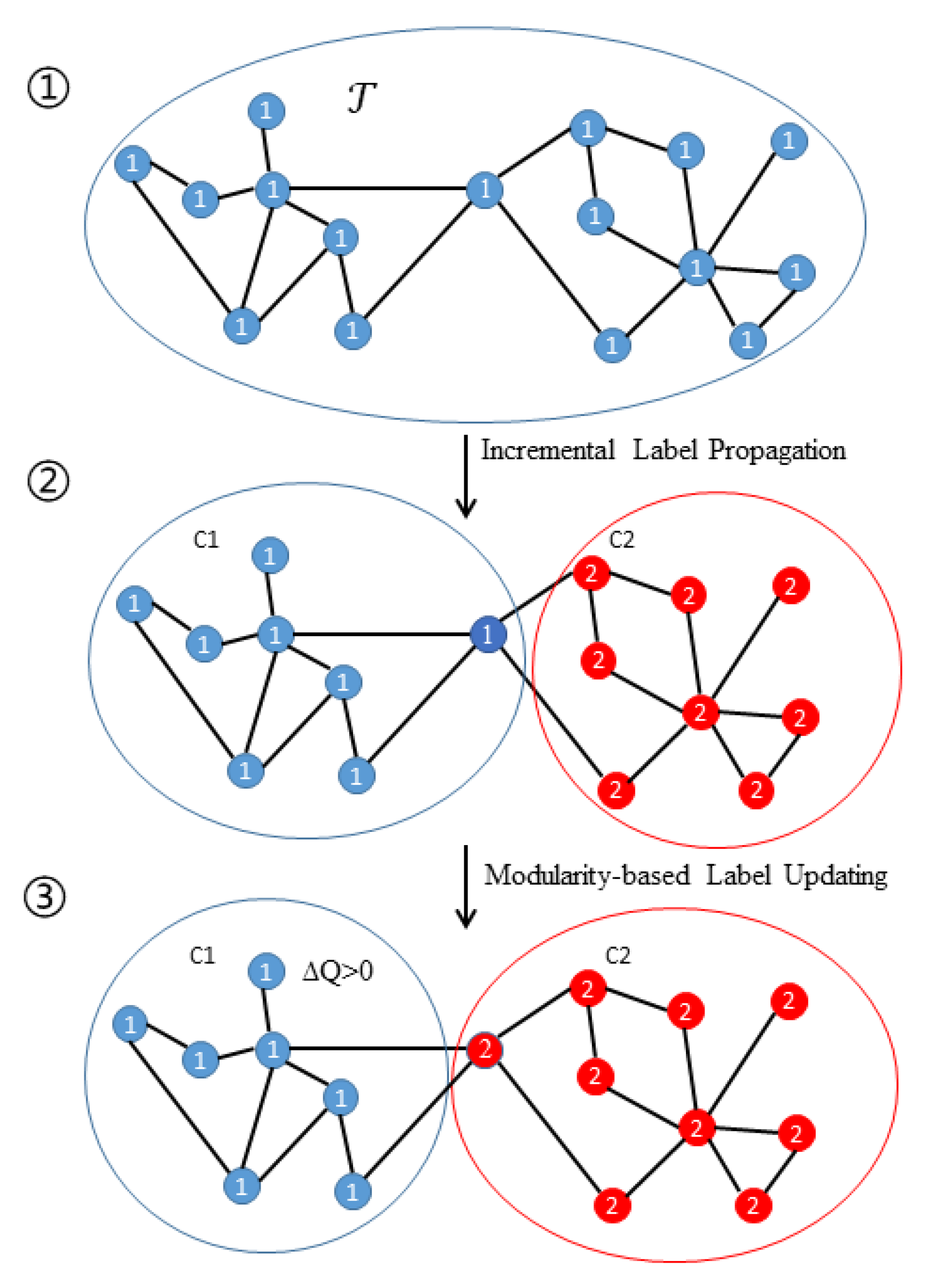
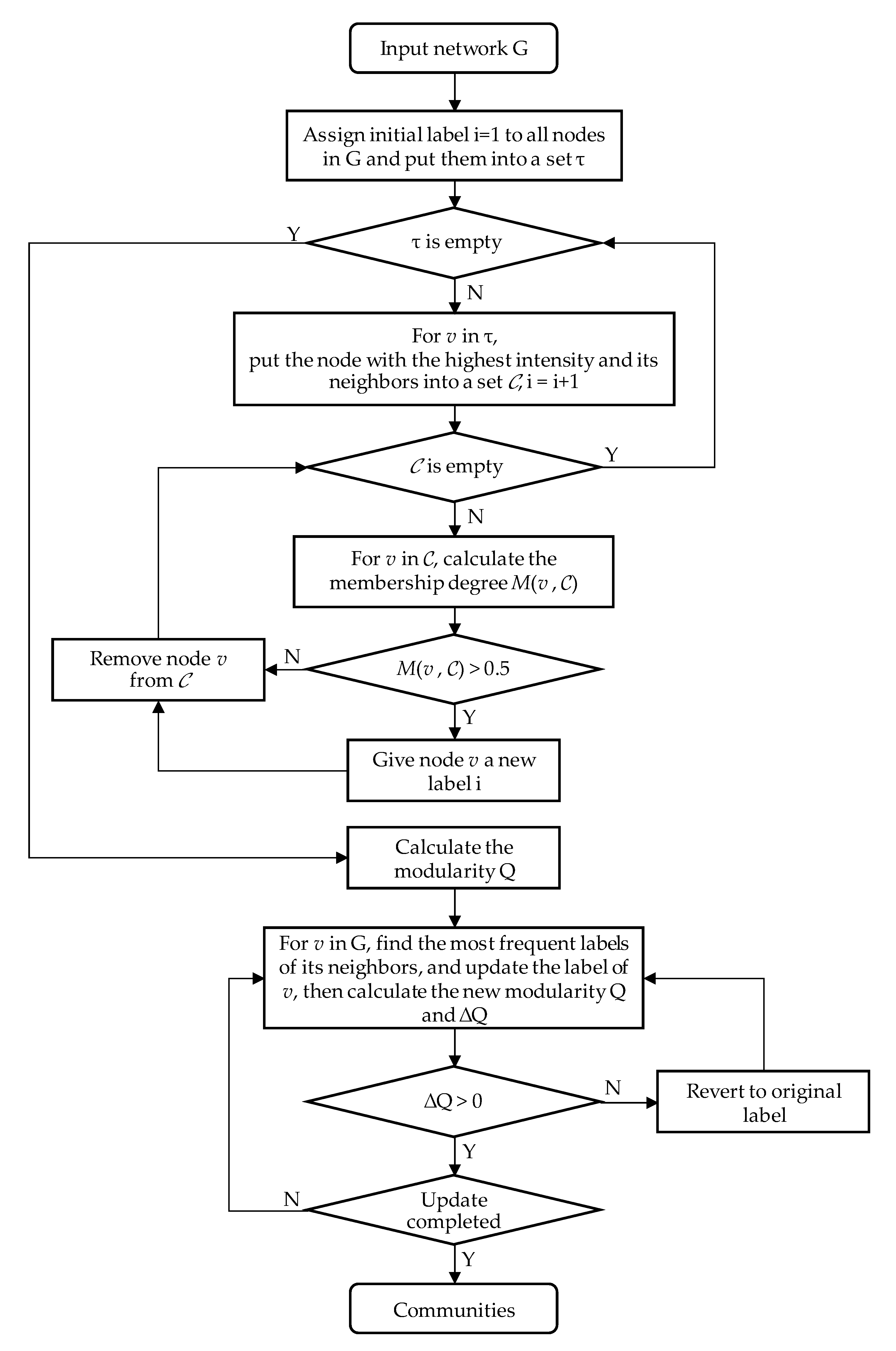
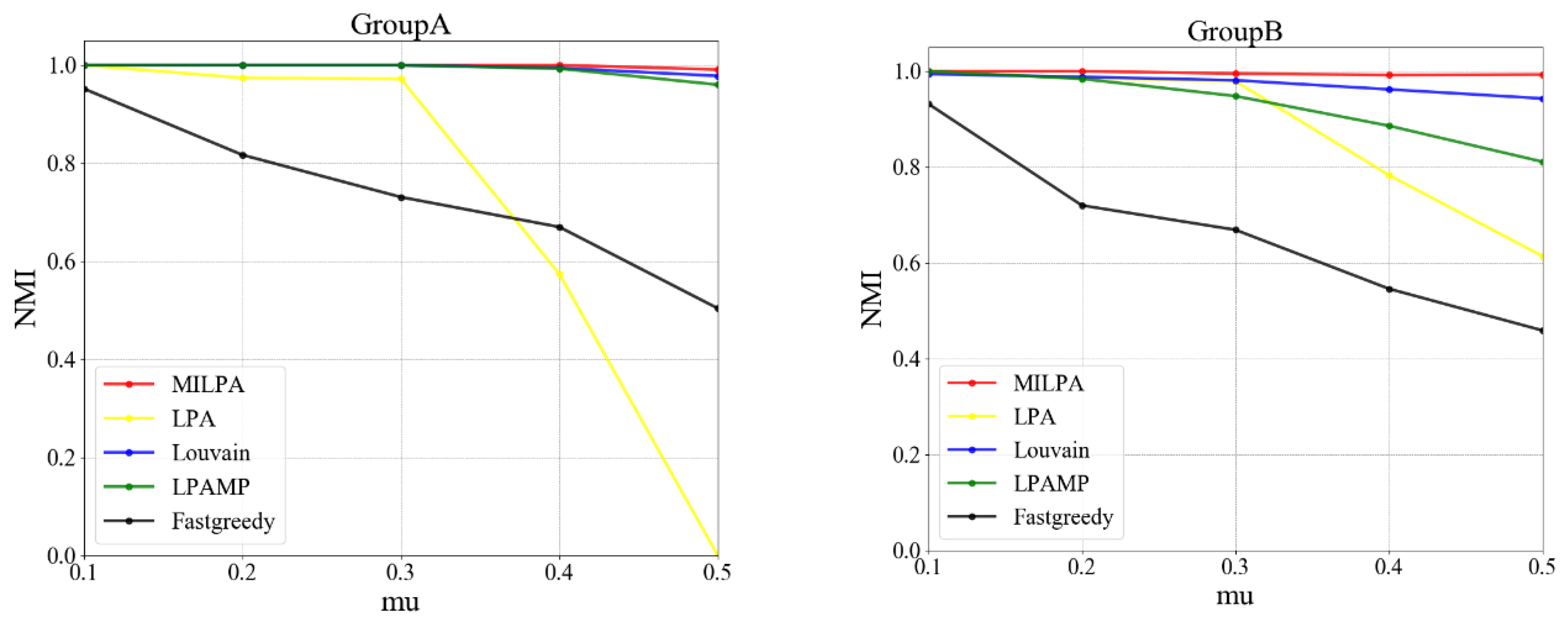
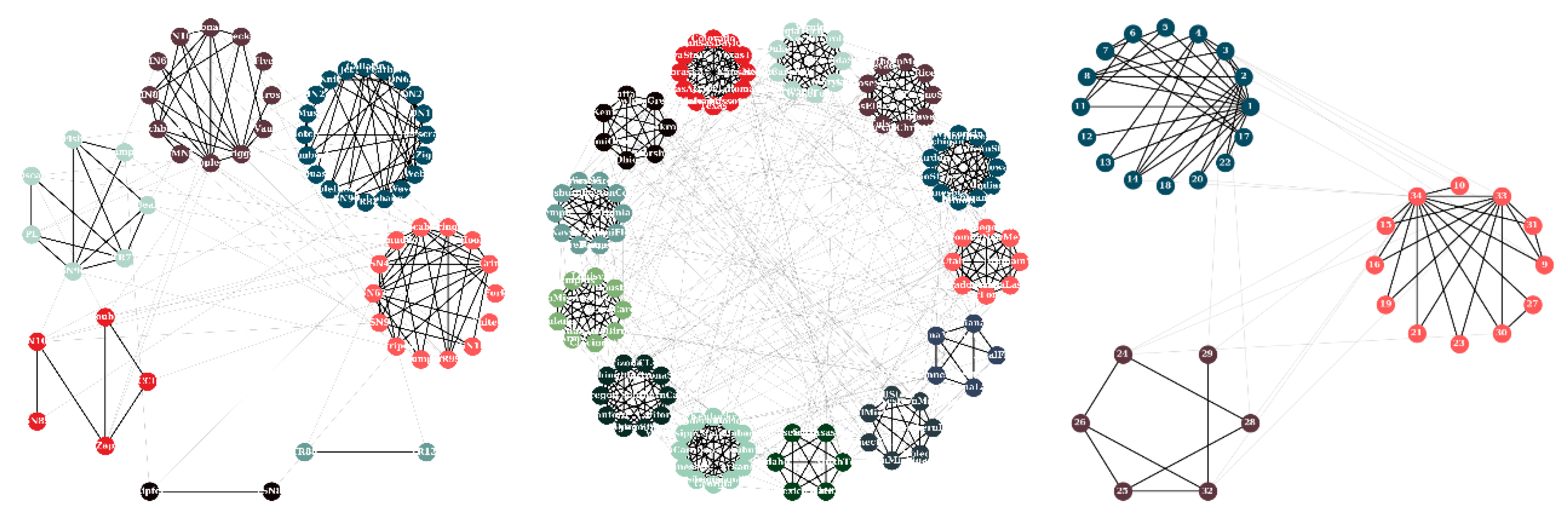

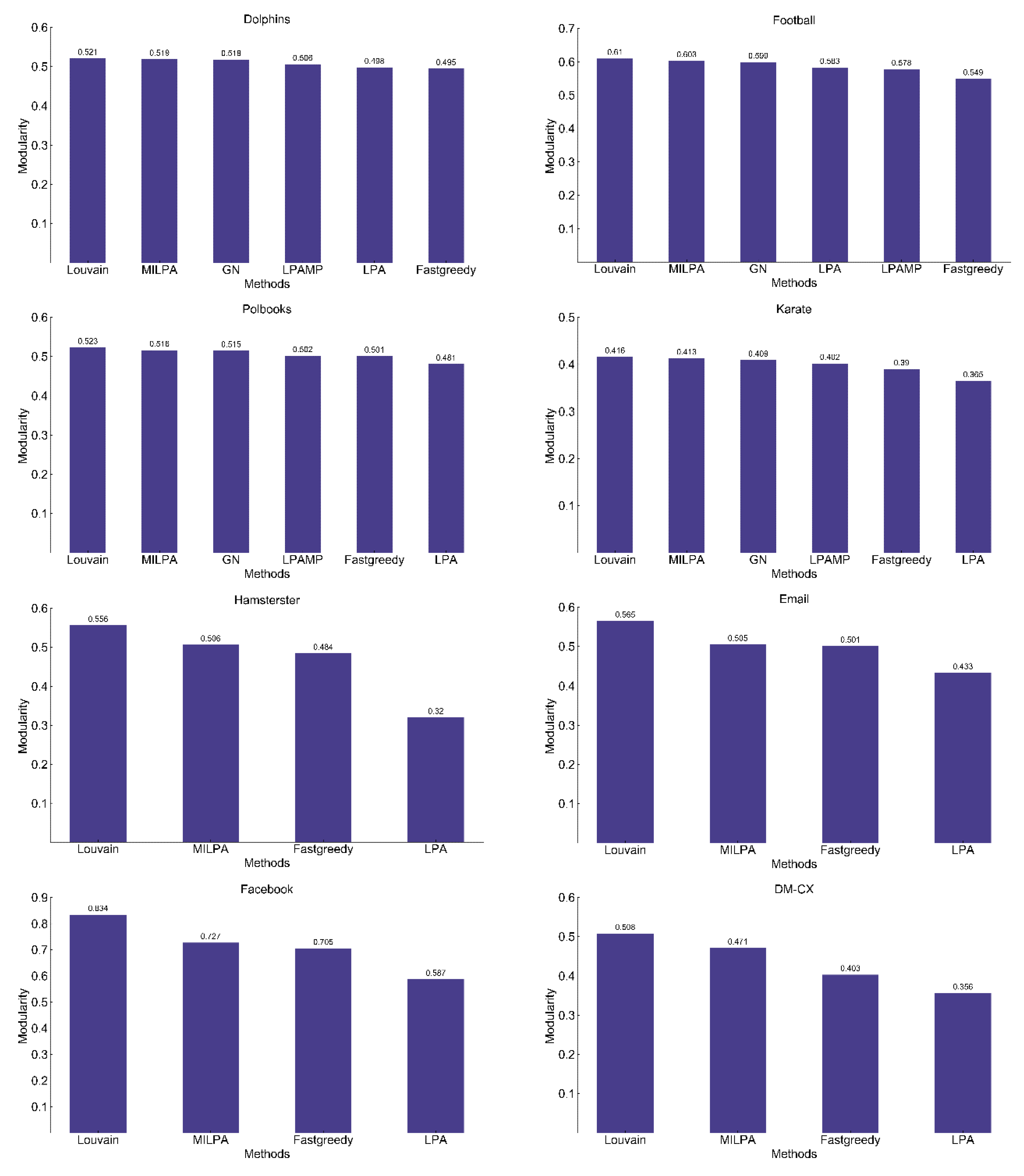
| Networks | N | Mink | Maxk | Minc | Maxc | Mu |
|---|---|---|---|---|---|---|
| Group A | 1000 | 20 | 50 | 20 | 100 | 0.1~0.5 |
| Group B | 5000 | 50 | 100 | 20 | 100 | 0.1~0.5 |
| Networks | Node Number | Edge Number |
|---|---|---|
| Karate | 34 | 78 |
| Dolphins | 61 | 159 |
| Polbooks | 105 | 441 |
| Football | 115 | 616 |
| 1133 | 5451 | |
| Hamsterster | 2426 | 16631 |
| DM-CX | 4040 | 76717 |
| 4039 | 88234 |
© 2020 by the authors. Licensee MDPI, Basel, Switzerland. This article is an open access article distributed under the terms and conditions of the Creative Commons Attribution (CC BY) license (http://creativecommons.org/licenses/by/4.0/).
Share and Cite
Ma, Y.; Zhao, Y.; Wang, J.; Liu, M.; Shen, W.; Ma, Y. Modularity-Based Incremental Label Propagation Algorithm for Community Detection. Appl. Sci. 2020, 10, 4060. https://doi.org/10.3390/app10124060
Ma Y, Zhao Y, Wang J, Liu M, Shen W, Ma Y. Modularity-Based Incremental Label Propagation Algorithm for Community Detection. Applied Sciences. 2020; 10(12):4060. https://doi.org/10.3390/app10124060
Chicago/Turabian StyleMa, Yunlong, Yukai Zhao, Jingwei Wang, Min Liu, Weiming Shen, and Yumin Ma. 2020. "Modularity-Based Incremental Label Propagation Algorithm for Community Detection" Applied Sciences 10, no. 12: 4060. https://doi.org/10.3390/app10124060
APA StyleMa, Y., Zhao, Y., Wang, J., Liu, M., Shen, W., & Ma, Y. (2020). Modularity-Based Incremental Label Propagation Algorithm for Community Detection. Applied Sciences, 10(12), 4060. https://doi.org/10.3390/app10124060






